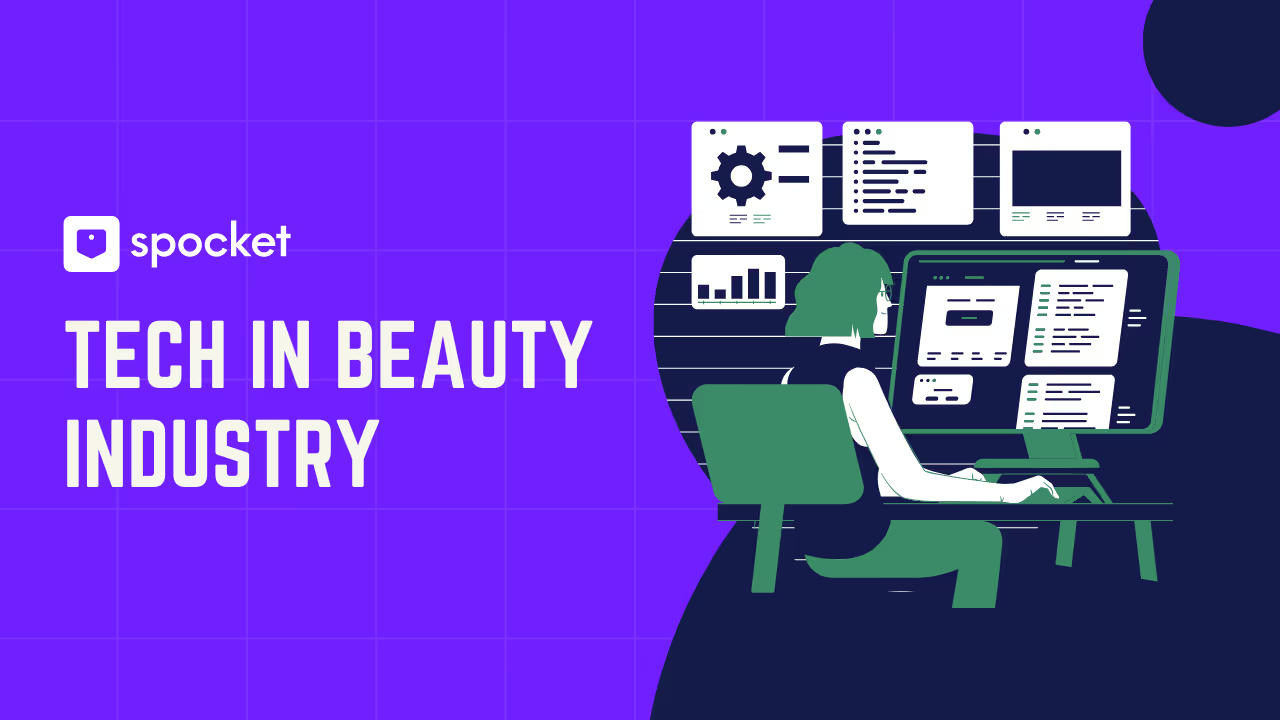Looking for a powerful website builder that gives you more flexibility, affordability, or customization than Webflow? You’re in the right place. In this guide, we’ll compare the best Webflow alternatives available in 2025 to help you find the perfect platform for your website creation needs. Whether you're a designer looking for advanced customization, an e-commerce entrepreneur, or a beginner just starting, we have you covered. We’ll explore no-code website builders that provide SEO optimization, team collaboration, and responsive designs. Ready to take your web design to the next level? Let’s dive in!
Why Consider Webflow Alternatives?
Webflow is a major player in the world of no-code website builders, known for its design flexibility, powerful CMS, and ability to create responsive, professional sites without writing code. However, while Webflow offers many powerful features, it might not always be the best fit for everyone. Let’s explore when you might want to consider other options.
Webflow Pricing and Features Overview
Webflow offers a variety of plans to suit different needs, starting with a free version for basic projects. Paid plans begin at $14/month for the Basic plan, $23/month for the CMS plan, and rise to custom pricing Enterprise plan. While Webflow provides great features, extra costs for hosting, workspaces, and advanced functionalities can add up quickly.
Key features of Webflow include its visual editor, custom code options, and robust team collaboration tools. It's a go-to platform for designers and agencies who require complete control over design and content. However, not everyone may need these extensive features, and the pricing structure may not be suitable for all users.
Who Should Use Webflow? (And Who Might Need an Alternative)
Webflow is ideal for users looking for a design-first website builder with powerful team collaboration. It's particularly suited for designers, agencies, and businesses that need complex layouts, custom animations, and advanced CMS features. If you’re building a portfolio, marketing site, or agency website, Webflow is a top choice.
However, if you’re operating on a tight budget, need a simpler setup, or are looking for more e-commerce features or plugin options, exploring Webflow alternatives might be a good idea. Small businesses, startups, bloggers, and solo entrepreneurs often find other platforms to be more user-friendly and cost-effective.
Common Reasons to Look for Webflow Alternatives
There are several reasons why users might look for Webflow alternatives:
- Cost: Webflow’s pricing can be high, especially with workspace fees and extra hosting costs, which may not be ideal for growing teams or businesses on a budget.
- Ease of Use: Some users find Webflow’s learning curve too steep, especially if they prefer a simpler, drag-and-drop builder.
- E-commerce: Platforms like Shopify or WooCommerce often offer stronger e-commerce features right out of the box, making them better suited for online stores.
- Plugin Ecosystem: Platforms like WordPress and Elementor provide access to thousands of plugins and themes, which makes adding features and scaling your site easier.
- Open Source Options: If you prefer full control and ownership, open source alternatives like WordPress (self-hosted) or static site generators might be more attractive.
- Free Plans: Many competitors, such as Wix and Weebly, offer free plans or more affordable entry points for new users.
- Community and Support: Larger communities and more support resources are available with platforms like WordPress, Wix, or Shopify, which some users prefer.
Top Webflow Alternatives for 2025
While Webflow remains a strong player in the no-code website builder market, it's not the only option available. In 2025, many small businesses and freelancers are seeking alternatives that offer better pricing, user-friendly interfaces, or stronger e-commerce capabilities. Here’s a comprehensive look at the top contenders for Webflow alternatives.
1. Ycode
Ycode is a fresh entrant in the market, but it has quickly gained traction with its modern, intuitive interface. Designed for both designers and content editors, Ycode stands out as a Webflow competitor for teams looking for an efficient and affordable website-building platform.
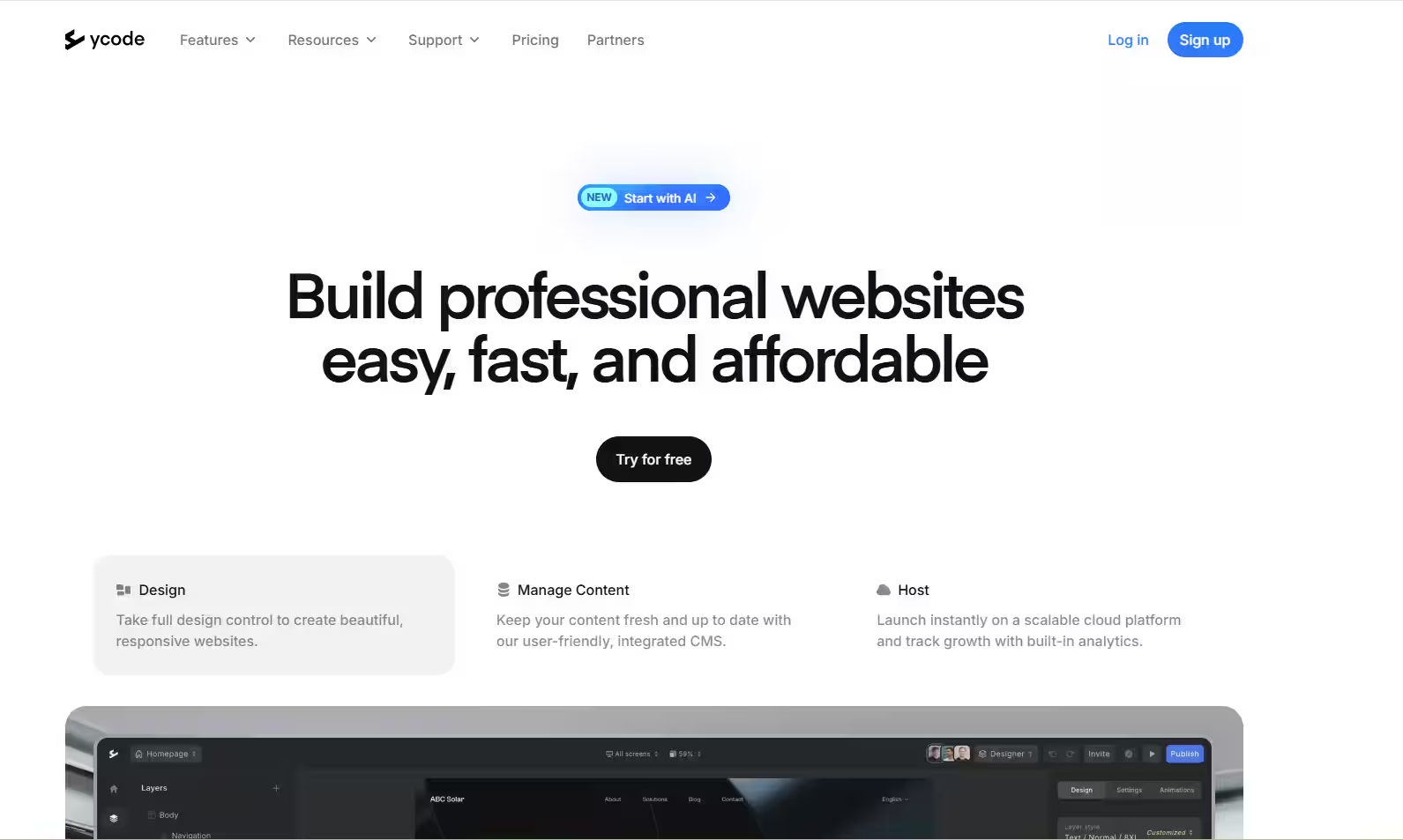
Key Features
- Visual design tools with built-in animations
- Powerful CMS for easy content management
- Team collaboration at no extra cost
- Responsive controls for all devices
- Advanced form builder
Pros
- Free workspaces and user management (unlike Webflow)
- Easy to learn, even for beginners
- Affordable, Pay only for hosting
- Full control without coding
Cons
- Newer platform, so the community is still growing
- Fewer templates than established competitors
Why Choose Ycode?
Ycode is perfect if you want a modern, affordable, team-friendly website builder. It’s a top Webflow alternative for startups and agencies who want to save on costs and collaborate easily.
Pricing
Hosting plans start at $5/month. Free workspaces for team members.
2. Framer
Framer is known for its design-first approach and is a favorite among designers who want to prototype and build visually stunning websites.
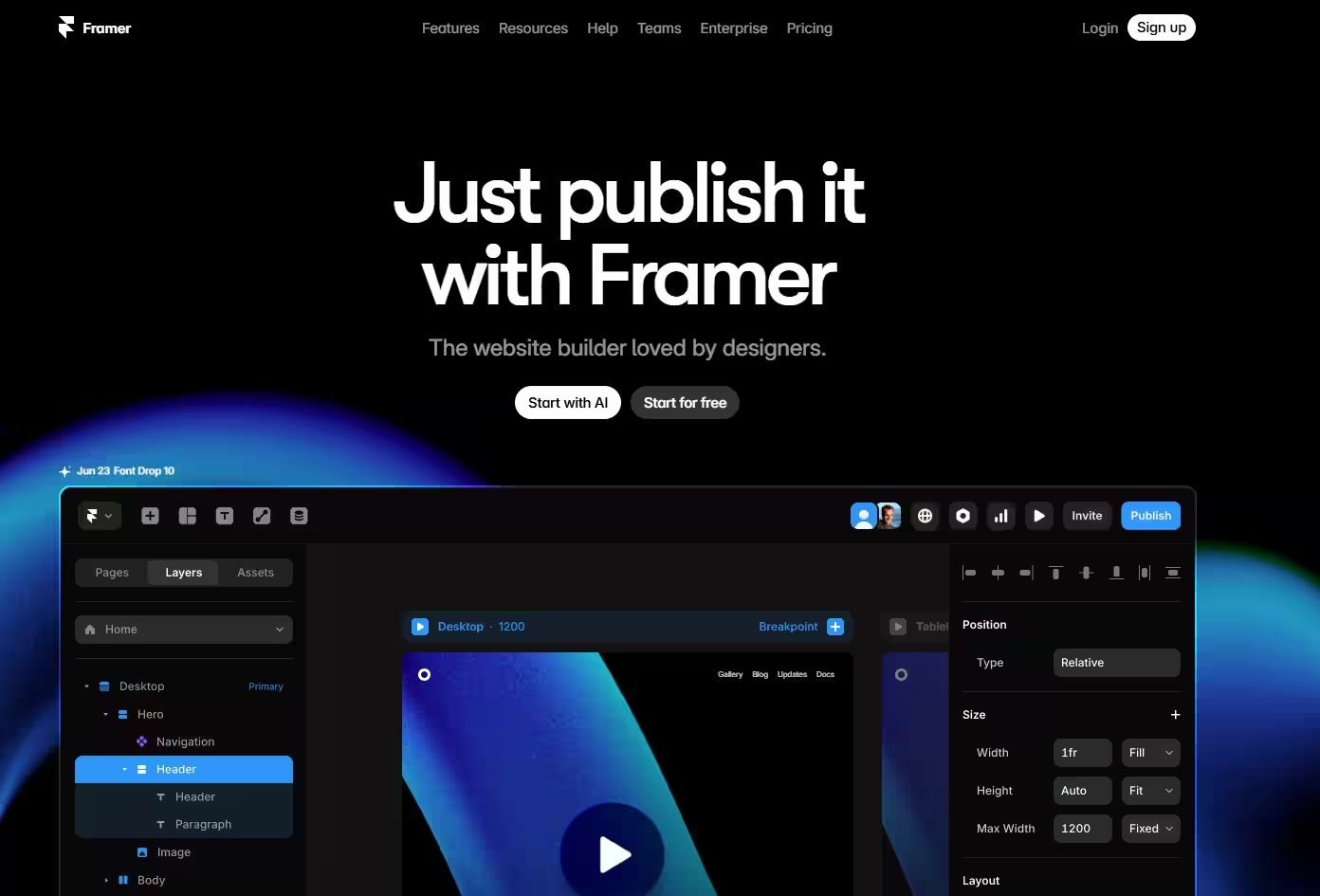
Key Features
- Advanced animation and interaction tools
- Intuitive drag-and-drop editor
- Built-in CMS for content updates
- Responsive design controls
Pros
- Great for designers who want to impress clients
- Fast prototyping and live previews
- Easy to use for both static and dynamic sites
Cons
- Limited e-commerce features
- Can be pricey for advanced features
Why Choose Framer?
Choose Framer if you value design flexibility and want to create visually impressive websites. It’s a strong Framer vs Webflow choice for creative professionals looking to push the limits of design.
Pricing
Free plan available. Paid plans start at $10/month for more features.
3. Wix Studio
Wix Studio is Wix’s answer to Webflow, offering advanced features aimed at agencies and freelancers who want more control and customization over their projects.
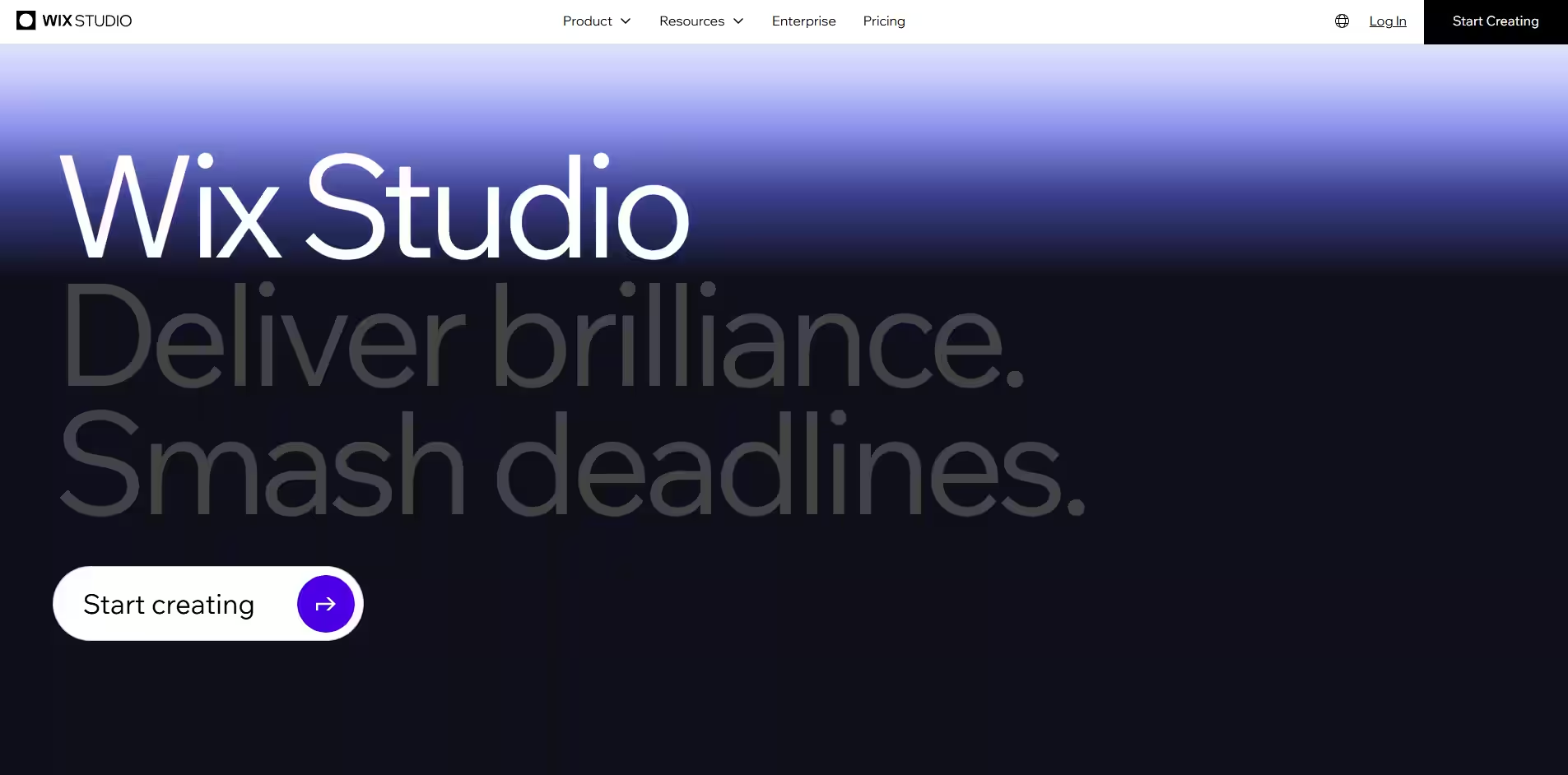
Key Features
- Drag-and-drop editor with advanced customization
- Hundreds of templates and apps
- Team collaboration features
- Strong SEO and analytics tools
Pros
- Easy to use, even for beginners
- Many third-party integrations
- Great for e-commerce and marketing sites
Cons
- Can get expensive with add-ons
- Not as flexible as Webflow for complex animations
Why Choose Wix Studio?
Wix Studio is ideal if you want a balance of ease and power. It’s one of the best website builders for small businesses and agencies that need a blend of customization and simplicity.
Pricing
Free plan available. Paid plans start at $12/month.
4. WordPress
WordPress is the world’s most popular content management system (CMS), known for its flexibility and open-source nature. It powers over 40% of all websites and remains a strong contender as a Webflow alternatives open source option.
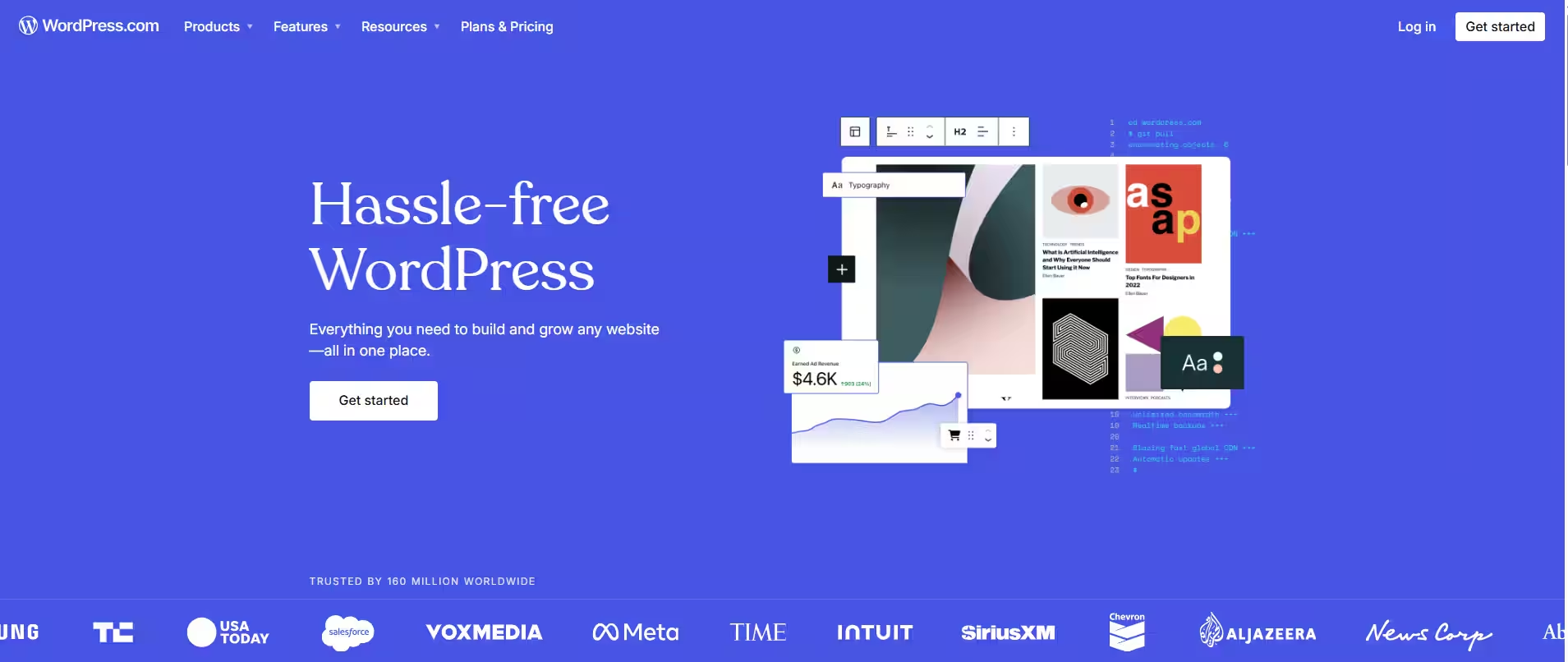
Key Features
- Thousands of themes and plugins
- Full control over design and functionality
- Strong SEO and blogging tools
- Large, active community
Pros
- Highly customizable
- Great for blogs, portfolios, and business sites
- Free to use, but you pay for hosting and premium features
Cons
- Steeper learning curve for beginners
- Requires more maintenance
Why Choose WordPress?
WordPress offers endless customization possibilities and strong SEO tools. It’s perfect for those who want full control over their website and are looking for an open-source alternative to Webflow.
Pricing
WordPress is free, but hosting and premium features cost extra. Expect to pay $4–$25/month for shared hosting.
5. Squarespace
Squarespace is the go-to platform for anyone who wants a beautiful website quickly. Trusted by over 4 million websites, Squarespace is known for its polished templates and intuitive drag-and-drop editor. It's perfect for users who want to impress without the hassle.
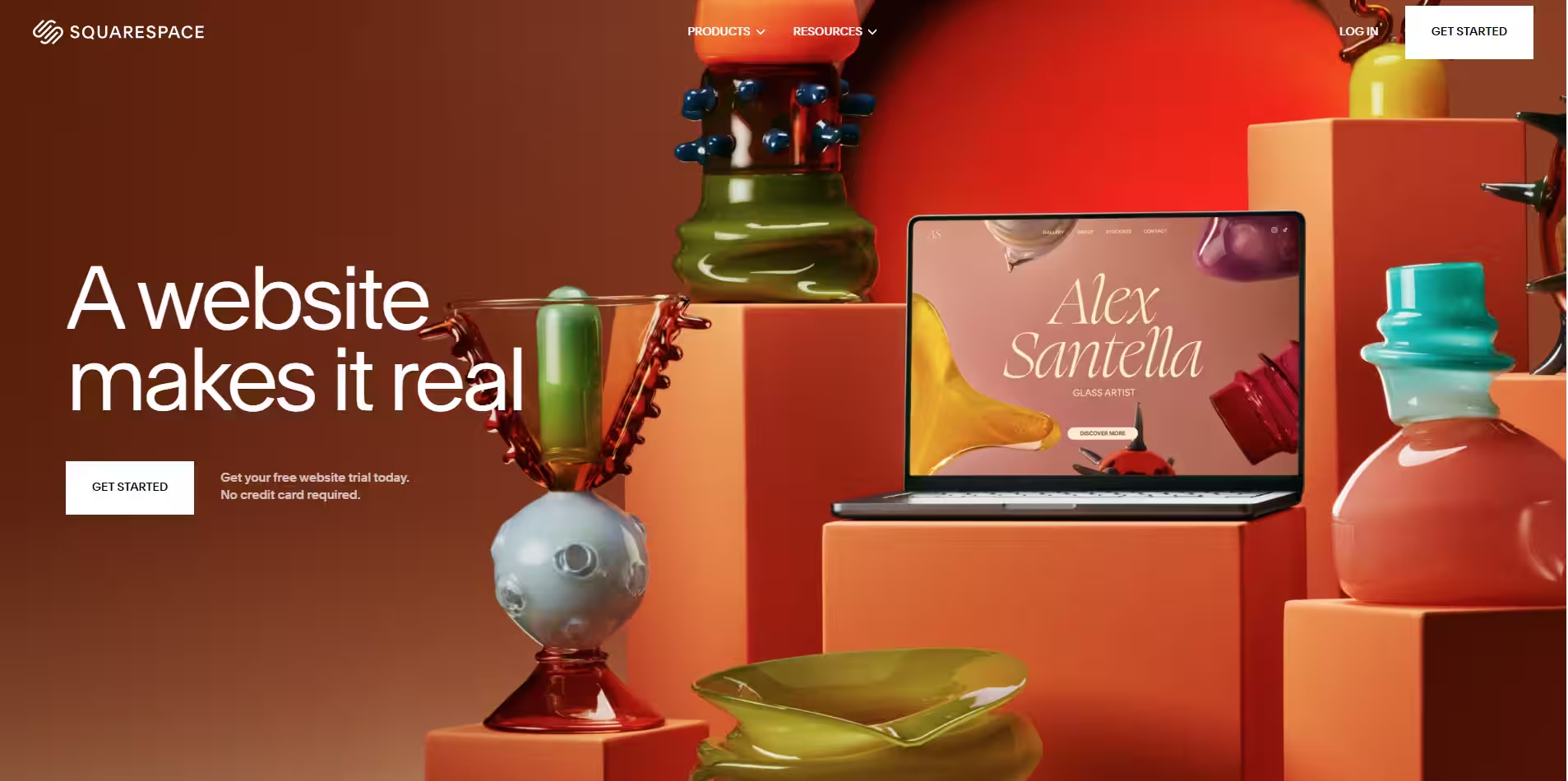
Key Features
- Gorgeous, ready-made templates
- Easy-to-use editor
- Built-in SEO and marketing tools
- Reliable hosting and security
- Solid blogging and e-commerce features
Pros
- Super easy for beginners
- 24/7 customer support
- All-in-one solution for small sites
- Stunning design out of the box
Cons
- Less design flexibility than Webflow
- Fewer advanced customization options
- No free plan—just a 14-day trial
Why Choose Squarespace?
Pick Squarespace if you want a stunning, hassle-free website. It’s perfect for portfolios, blogs, and small businesses. If you value ease over deep customization, this is your best website builder.
Pricing
Plans start at $16/month. No free plan, but a 14-day free trial.
6. Shopify (For E-commerce)
Shopify powers over 4.4 million active stores worldwide, making it the top choice for anyone serious about selling online. If you want to launch an e-commerce site, Shopify is hard to beat.

Key Features
- Powerful online store builder
- Hundreds of professional themes
- Secure checkout and payment options
- Built-in marketing and analytics
- Huge app store for extra features
Pros
- Best-in-class for e-commerce
- Easy to set up and manage
- Massive app ecosystem
- Reliable uptime and security
Cons
- Not ideal for non-store websites
- Transaction fees unless you use Shopify Payments
- Can get expensive with add-ons
Why Choose Shopify?
Choose Shopify if you want to sell online. It’s the ultimate e-commerce website builder for startups and established brands.
Pricing
Plans start at $29/month. Free trial available.
7. Dorik
Dorik is a rising star among no-code website builders. It’s designed for speed and simplicity, making it a great Webflow alternative for startups and solo creators who want to get online quickly.
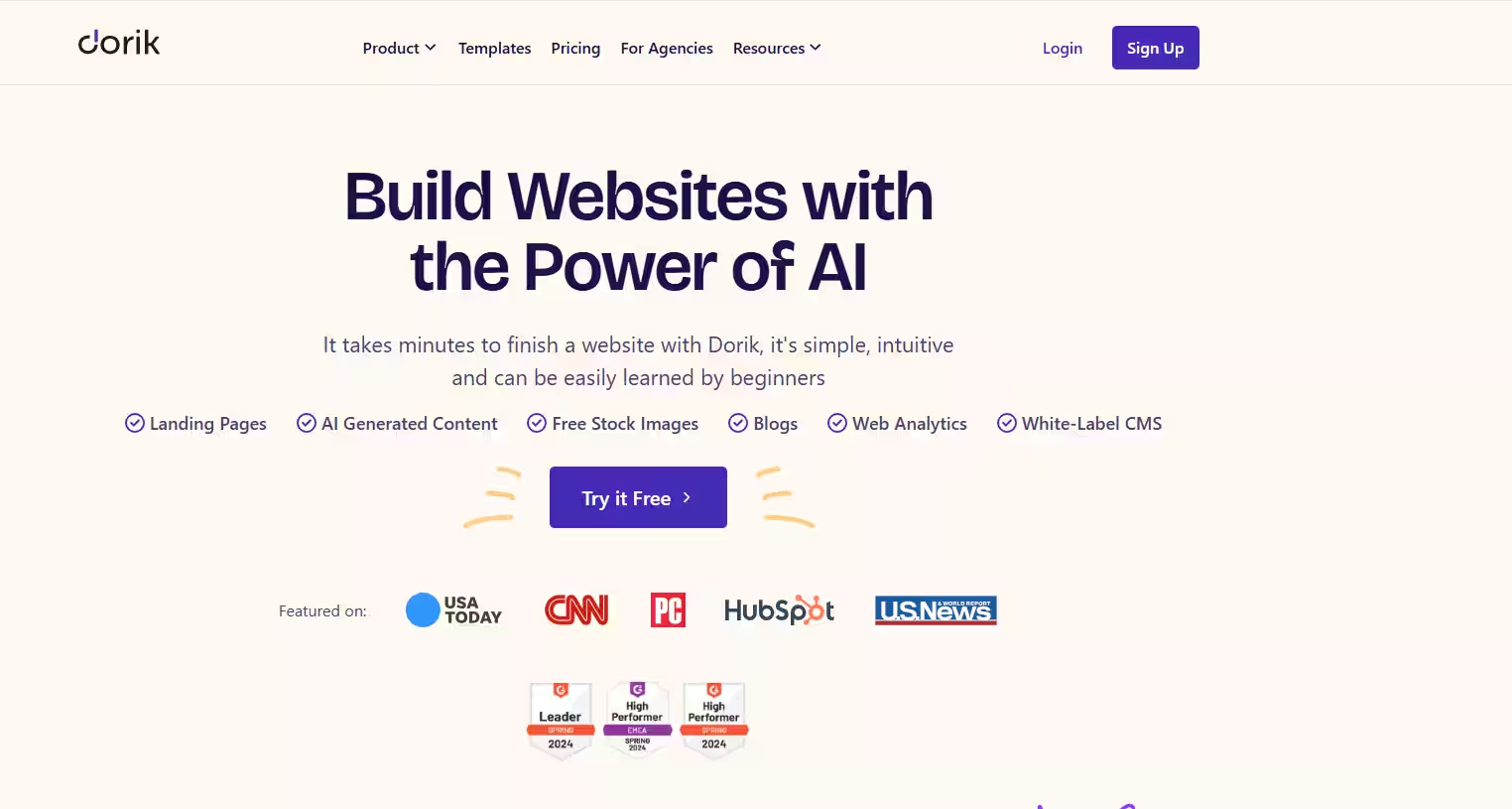
Key Features
- Drag-and-drop builder
- Free and paid templates
- Built-in CMS and blogging
- Fast, responsive designs
- Easy SEO tools
Pros
- Affordable pricing
- Super easy to use
- Great for landing pages and simple sites
- Good for beginners and small teams
Cons
- Fewer advanced features than Webflow
- Limited integrations
- Not as powerful for complex sites
Why Choose Dorik?
Pick Dorik if you want a fast, easy, and inexpensive way to get online. It's perfect for landing pages, portfolios, and small business sites.
Pricing
Free plan available. Paid plans start at $14/month.
8. Unicorn Platform
Unicorn Platform is built specifically for startups and SaaS founders. It’s a niche builder focused on fast product launches, with built-in features for app and service launches.
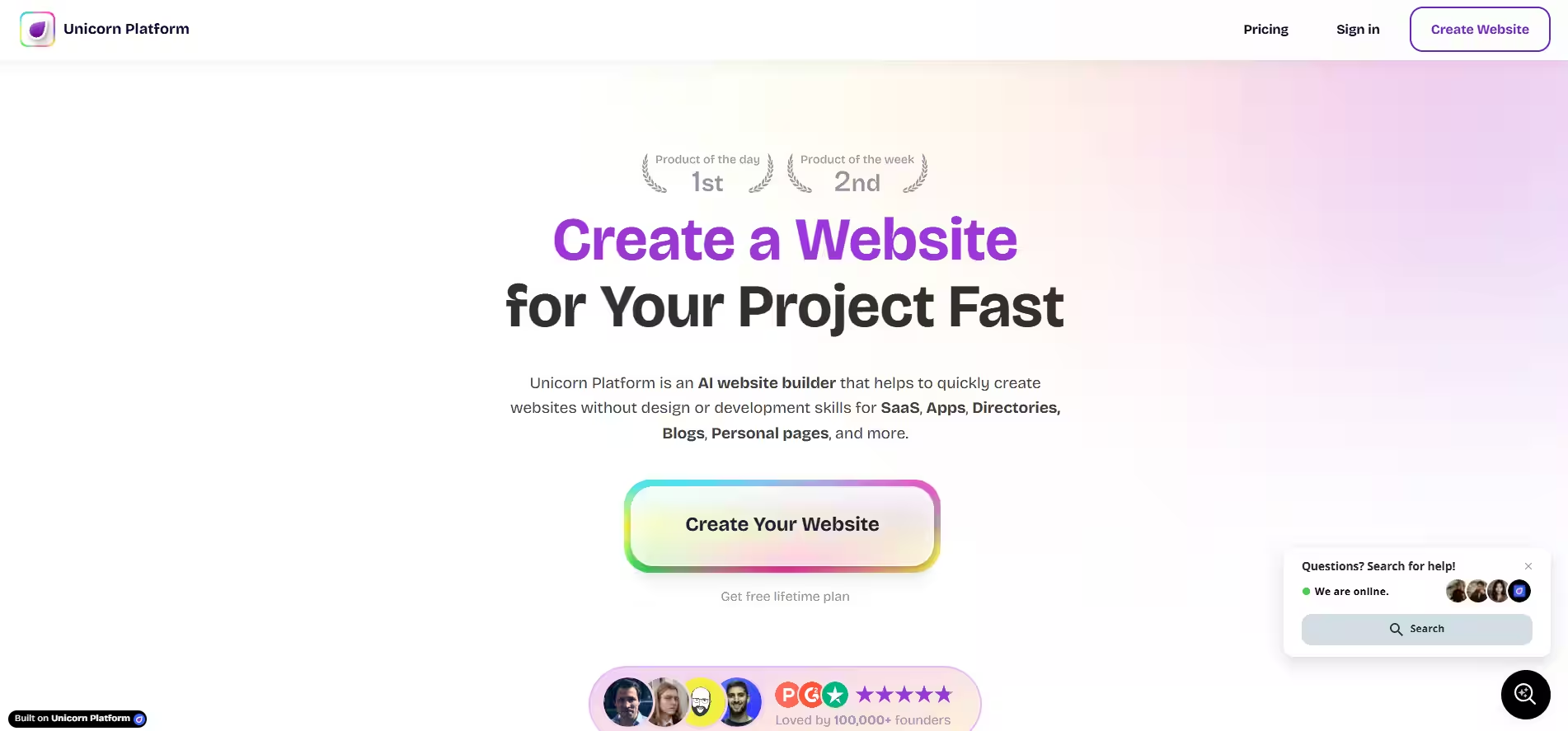
Key Features
- Drag-and-drop builder
- Built-in analytics and forms
- Pre-built sections for startups
- Easy integrations with tools like Calendly and Stripe
- Responsive and fast
Pros
- Perfect for startups and SaaS
- Fast setup and launch
- Affordable pricing
- Built-in marketing features
Cons
- Not as flexible as Webflow
- Limited design options
- Best for specific use cases
Why Choose Unicorn Platform?
Choose Unicorn Platform if you’re a startup founder or launching a SaaS. It’s the fastest way to get a professional site online.
Pricing
Free plan available. Paid plans start at $9/month.
9. Typedream
Typedream is a relatively new player in the no-code website builder world, launched in 2021. It has quickly gained popularity, especially among creators and startups, thanks to its simplicity and Notion-style workflow. Over 100,000 sites have been built using Typedream, making it an appealing choice for those who want an easy-to-manage online presence.
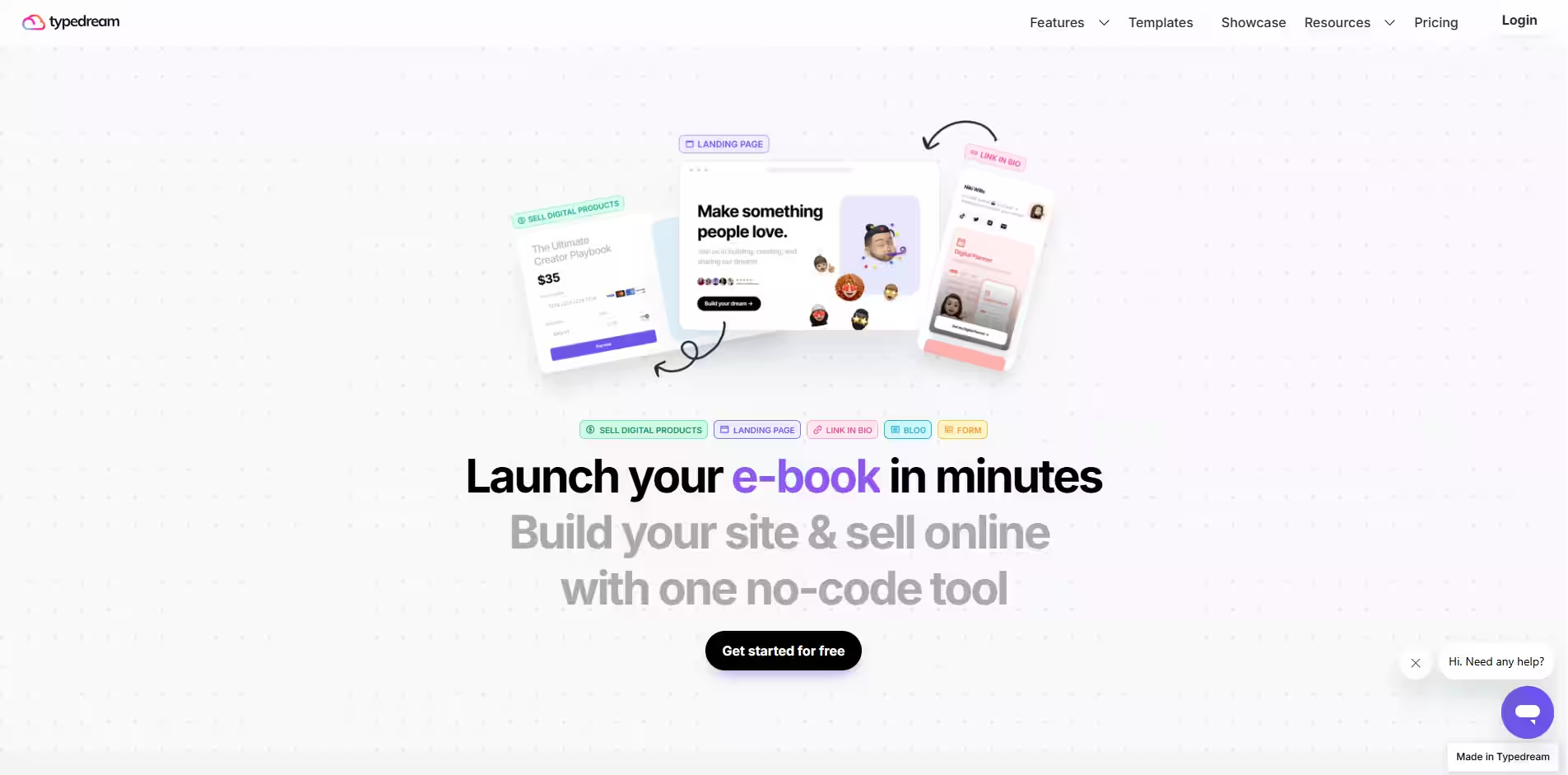
Key Features
- AI-powered website creation
- Drag-and-drop editor
- Notion integration
- SEO tools and analytics
- Team collaboration
Pros
- Super easy to use
- Fast setup
- Notion integration
- Affordable pricing
- Good customer support and growing community.
Cons
- Limited templates
- Not ideal for online stores.
- Not as flexible as Webflow or Framer.
- Smaller community
Why Choose Typedream?
Pick Typedream if you want a fast, simple, and affordable website builder. It's perfect for landing pages, personal branding, and content-driven sites. If you’re a fan of Notion, you’ll feel right at home with its seamless integration.
Pricing
- Free plan: Basic features, good for testing.
- Launch plan: $15/month (unlimited pages, custom domain, SEO, analytics).
- Grow plan: $49/month (protected pages, advanced analytics, more Notion features).
10. Super
Super is a rising star for anyone who wants to turn Notion pages into beautiful, public websites. It’s specifically designed for creators, startups, and remote teams who already use Notion for content management and want an easy, no-code way to publish it online. Super is lightweight, fast, and focused on simplicity.
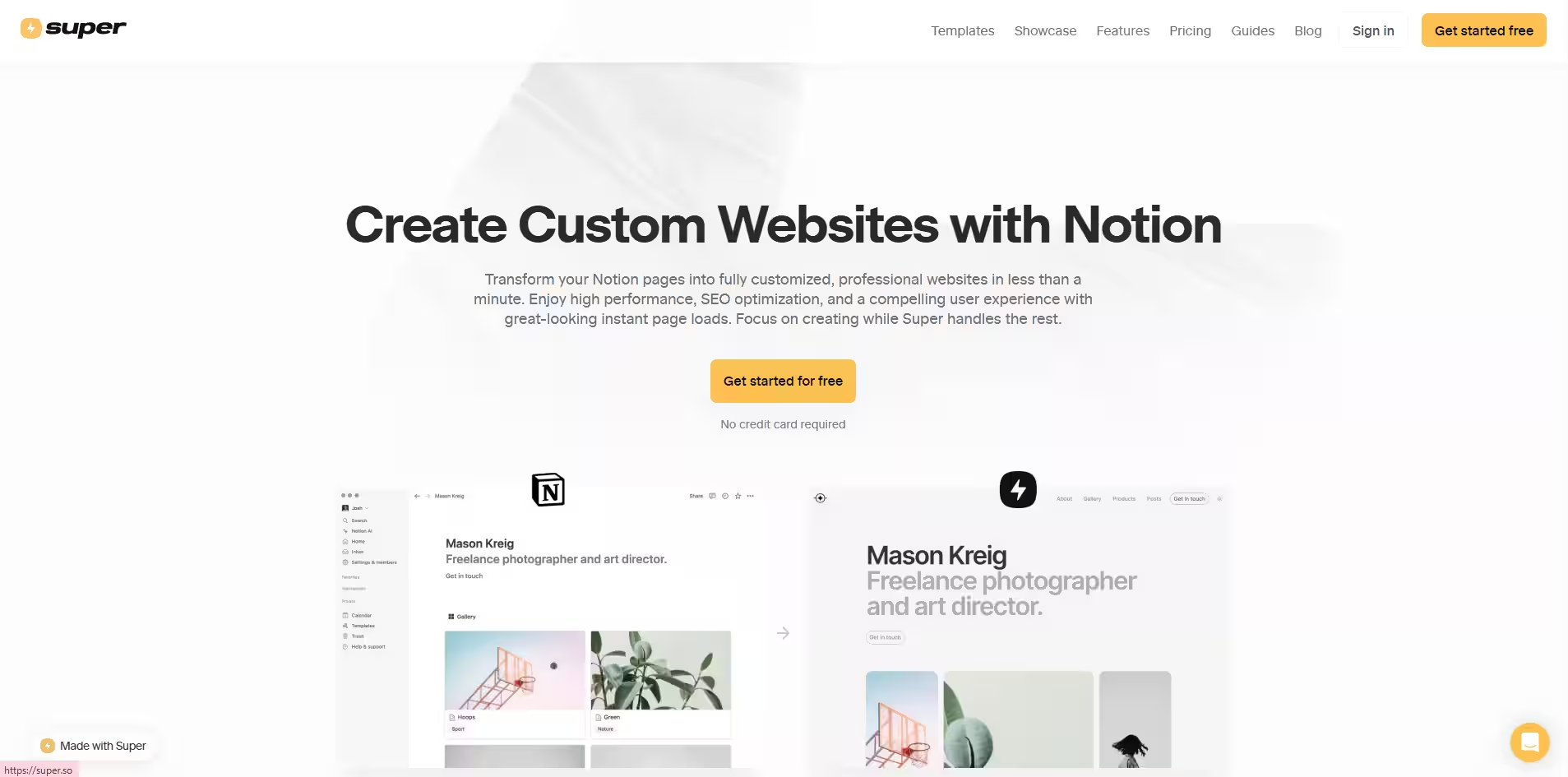
Key Features
- Notion-powered websites.
- Custom domains
- SEO tools
- Design customization
- Privacy controls
Pros
- Ultra-easy setup
- Seamless Notion integration
- Affordable pricing
- Responsive design
Cons
- Limited design flexibility
- No e-commerce
- Notion dependency
- Smaller community: Still growing.
Why Choose Super?
Choose Super if you want to quickly turn your Notion content into a website. It's ideal for portfolios, blogs, and team sites. If you already use Notion, Super makes it incredibly easy to publish content online.
Pricing
- Free plan: Basic features, with Super branding.
- Personal plan: $16/month (custom domain, advanced SEO).
- TPro plan: $28/month (multiple sites, more collaborators).
How to Choose the Best Webflow Alternative
Today the majority of small businesses and startups now use website builders to launch their online presence. The right platform depends on your goals, budget, and who you work with. Here’s how you can choose the best Webflow competitor for your project.
Key Considerations for Selecting a Website Builder
When choosing a website builder, it’s important to think about what matters most to you. Consider the following factors:
- Ease of use: Do you need a simple, beginner-friendly interface, or are you looking for advanced features?
- Budget: How much can you afford to spend? Do you need a free plan or are you willing to invest more for additional features?
- Team collaboration: Do you need a platform that allows you to easily work with a team?
- Design & Customization: How much control do you want over your site’s design?
- E-commerce: Do you plan to sell online?
- Long-term goals: Consider how the platform will serve you in the future as your website grows.
Each Webflow alternative shines in different areas, so it's crucial to align your choice with your specific needs.
Webflow vs. Other Platforms: What to Compare
To make an informed decision, here are the key factors to compare between Webflow and its competitors:
Ease of Use and Learning Curve
Some platforms, like Wix and Squarespace, make website building easy, especially for beginners. WordPress offers more power but comes with a steeper learning curve. If you’re looking for a no-code website builder with an intuitive design experience, Ycode or Dorik are great options to consider.
Pricing and Value for Money
Webflow starts at $12/month for basic features, but additional costs can add up for team workspaces and hosting. Alternatives like Ycode offer free workspaces and affordable hosting, starting at $5/month. On the other hand, Shopify is tailored for e-commerce but has a higher price point due to its robust features for online stores.
Design Flexibility and Customization
Webflow is well-known for its design flexibility. If you want similar control, consider Framer or Wix Studio, both of which allow advanced design tweaks. If you prefer using pre-made templates with less custom tweaking, Squarespace or Typedream could be more your speed. Always check if the platform allows custom domains and offers a responsive website builder.
Team Collaboration and User Management
If you work with a team, team collaboration is a key factor. Webflow charges extra for team workspaces, while Ycode and Wix Studio offer affordable or free team features. Be sure to check if the platform allows you to manage users, share projects, and set up permissions.
SEO, Analytics, and Marketing Tools
SEO is crucial for driving traffic and growth. Most top website builders offer built-in SEO tools, analytics, and marketing features. WordPress leads the pack for advanced SEO capabilities, while platforms like Wix and Squarespace are great for beginners looking for easy SEO tools. Always compare the analytics and integrations each platform offers.
E-commerce and Integration Capabilities
If you plan to sell products online, it’s essential to check the e-commerce features of each platform. Shopify, BigCommerce, and WooCommerce excel in e-commerce compared to Webflow. Additionally, consider integration capabilities—look for platforms that offer app stores or easy API access for tools like Notion, Zapier, or payment gateways.
Quick Tips for Choosing
- Startups and small teams: Try Ycode, Dorik, or Unicorn Platform for simplicity and affordability.
- Designers and agencies: Look into Framer, Wix Studio, or Webflow for flexibility and advanced design control.
- E-commerce: Choose Shopify, WooCommerce, or BigCommerce for robust online store capabilities.
- Content creators and bloggers: Consider WordPress, Typedream, or Super for ease of use and content management.
Webflow Alternatives: Free and Open Source
Many top website builders now offer free plans or open source code, enabling you to launch a site without any cost or fully customize it if you have the technical skills. Here’s how free and open source Webflow alternatives compare.
Free Webflow Alternatives
You don’t always need to pay for a great website. Several platforms let you build and publish for free, though some come with limitations.
- Dorik: Offers a free plan with basic features, making it perfect for landing pages, portfolios, and small business sites. You get a subdomain, but you can upgrade for custom domains and additional features.
- Unicorn Platform: Has a free tier for simple sites. Ideal for startups and SaaS founders looking to quickly test ideas.
- Typedream and Super: Both platforms allow you to create Notion-powered sites for free, with branding. You can upgrade for custom domains and additional features.
- Wix: Provides a free plan with Wix-branded domains. It’s beginner-friendly and great for testing ideas.
- SITE123: Offers a free plan with limited bandwidth and storage. It's simple and great for quick projects.
Note: Free plans usually have branding, limited storage, or basic features, but they are an excellent way to start if you’re on a budget or just learning.
Why Choose Free Webflow Alternatives?
Free website builders are perfect for testing ideas, building a portfolio, or launching a side project. They save you money and let you experiment before committing to a paid plan.
Open Source Webflow Alternatives
For those who want complete control, open source website builders are the best option. You can host them anywhere, fully customize every aspect, and never pay for licensing.
- WordPress (self-hosted): The most popular open source CMS, powering over 40% of all websites. It’s versatile for blogs, portfolios, and e-commerce with WooCommerce.
- Builder: A visual, open source website builder perfect for developers and agencies who want maximum flexibility.
- Webiny, WebStudio, Plasmic, Onlook: Modern open source tools for building websites and apps. They offer drag-and-drop editors and integrations similar to Webflow, ideal for developers.
- Drupal: A powerful open source CMS with a steeper learning curve, but highly flexible for complex projects.
Open source platforms offer unlimited design flexibility, team collaboration options, and the ability to add custom code, use any hosting, and scale as needed.
Why Choose Open Source Webflow Alternatives?
Open source is ideal if you want full control, need custom features, or plan to scale. It’s perfect for developers, agencies, or anyone looking for a custom, future-proof site.
Conclusion
Choosing the best Webflow alternative depends on your unique needs. If you want design flexibility and team features, consider Ycode or Framer. For e-commerce, Shopify and WooCommerce excel. Squarespace and Wix are perfect for easy, beautiful sites, while WordPress offers unmatched customization. Free options like Dorik and Unicorn Platform fit small projects, and open source tools like WordPress (self-hosted) give full control. Think about your budget, skills, and goals—then pick the platform that matches. You now have all the info to make a smart choice among top Webflow competitors


































